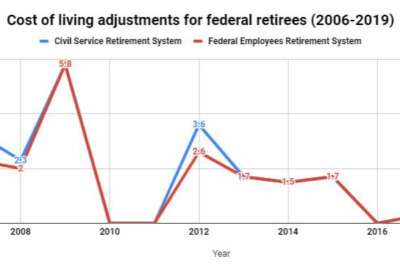

The slight upward creep in living costs in the first four months of this year points to a modest January 2020 cost-of-living adjustment.
The slight upward creep in living costs in the first four months of this year points to a modest January 2020 cost-of-living adjustment for federal and military retirees, and the tens of millions of Social Security beneficiaries. COLAS are based in urban living costs as measured by the Labor Department’s Consumer Price Index-W.
With 5 months — May, June, July, August and September— in the COLA countdown, the unofficial increase in January stands at 1.21%. But the actual amount of the increase, if any, will depend on the difference in the CPI for the third quarter — July, August and September — this year over the CPI-W level for the third quarter of 2018. Living costs actually declined by 0.45 and 0.47 in November and December of last year.
Retirees linked to the CPI-W got a 2.8% increase in January of this year if they were getting military retired pay, Social Security or civil service retirement system benefits, which includes most current federal retirees. People retired under the Federal Employees Retirement System program, which includes most people still working in government, are under a so-called diet COLA formula, which kept their January adjustment to 2%.
The National Active and Retired Federal Employees association believes that the CPI-W is the wrong yardstick to measure the impact of inflation for older retirees. Many agree with NARFE that a more equitable guideline would be the CPI-E (elderly), which takes into account the rate of inflation for medical procedures and drugs that take up a big part of the retirees monthly annuity.
The chart below shows the inflation and deflation rates since July 2018. But the numbers that count are those that will come out of the third quarter of this year.
| CPI-W | Monthly % Change | % Toward 2020 COLA | |
| July 2018 | 246.155 | -0.02 | – |
| Aug. 2018 | 246.336 | 0.07 | – |
| Sep. 2018 | 246.565 | 0.09 | – |
| Oct. 2018 | 247.038 | 0.19 | 0.28 |
| Nov. 2018 | 245.933 | -0.45 | -0.17 |
| Dec. 2018 | 244.786 | -0.47 | -0.64 |
| Jan. 2019 | 245.133 | 0.14 | -0.49 |
| Feb. 2019 | 246.218 | 0.44 | -0.05 |
| Mar. 2019 | 247.768 | 0.63 | 0.57 |
| Apr. 2019 | 249.332 | 0.63 | 1.21 |
By Alazar Moges
You have probably heard the phrase “sleep with one eye open” before. But for dolphins, it’s more than just an expression. The aquatic mammals can rest one half of their brain while the other remains awake. This method helps them battle sleep deprivation and remain vigilant for days at a time.
Source: Live Science
Copyright © 2025 Federal News Network. All rights reserved. This website is not intended for users located within the European Economic Area.
Mike Causey is senior correspondent for Federal News Network and writes his daily Federal Report column on federal employees’ pay, benefits and retirement.
Follow @mcauseyWFED

